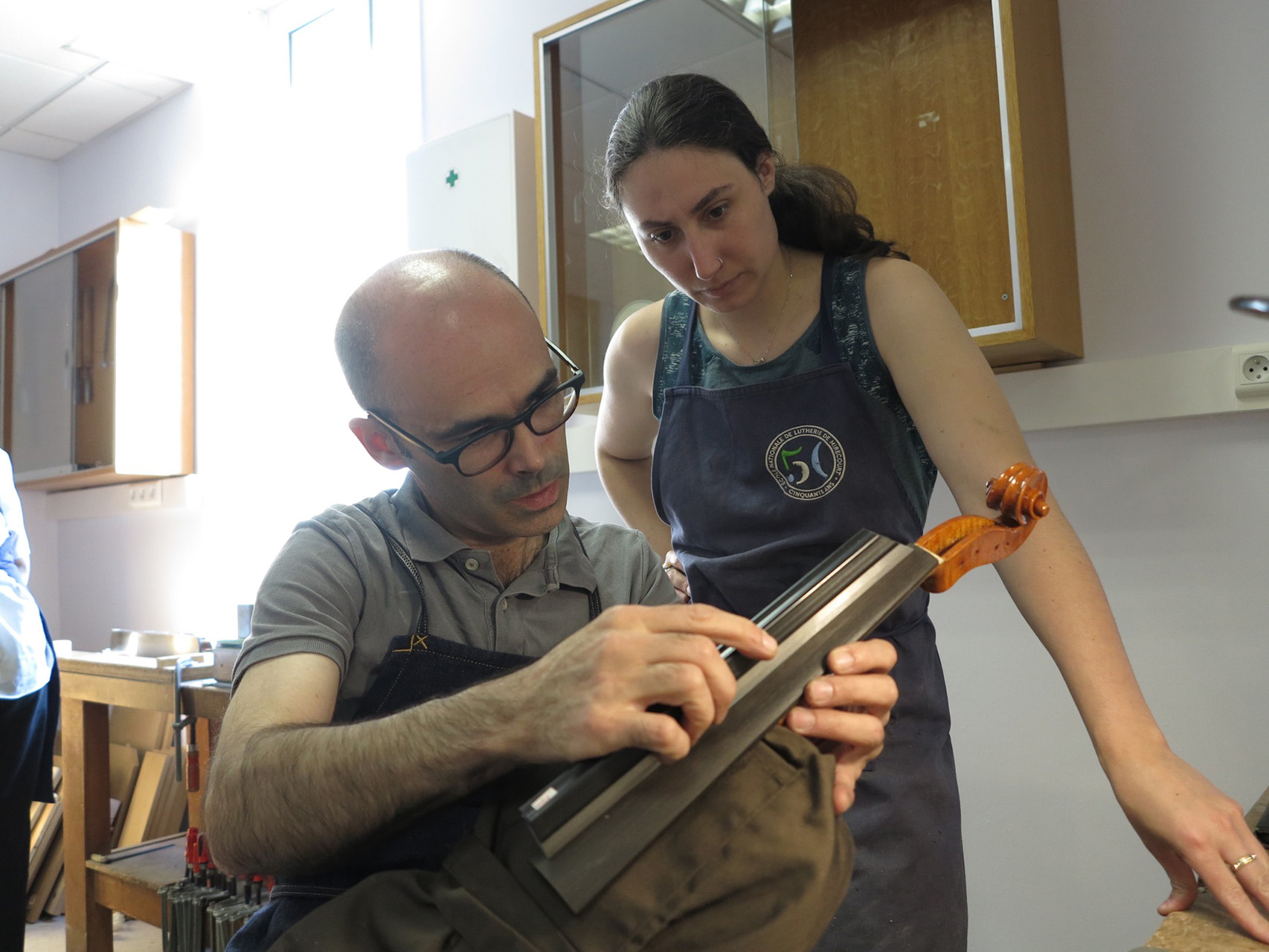Mirecourt National School of Violin Making – Year 2: Towards Mastery of Manufacturing Techniques
The second year at the National School of Violin Making in Mirecourt marks a turning point, as the apprentice luthier moves from an introduction to basic techniques to the gradual construction of the entire instrument. After a first year devoted to the discovery of wood, plans, and the musical world, this second year focuses on practical application and the acquisition of specialized skills: adjustments, bending, assembly, and varnishing.
1. Consolidation of knowledge of materials and tools
From the start of the school year, students reconnect with fine woods—curled maple for the back and sides, spruce for the soundboard—and deepen their understanding of their physical characteristics (density, resonance, and consistency). Advanced modules on animal glues, varnishes, and pigments teach the impact of each ingredient on sound and aesthetics.
At the same time, mastery of cutting tools (rip saw, handsaw, scroll saw with thin blades) and finishing tools (files, rifflers, rasps, hand sanders) is perfected. Each movement is analyzed and corrected to optimize precision and limit material loss.
2. Cutting and assembling the trays
One of the major challenges of the second year is the creation of the two instrument tops: the table and the back. Using templates and step-by-step instruction, the student learns to calibrate the thickness of the wood—respecting the graduation specific to each instrument—then to trace and cut the curve of the back. The installation of the connecting pins and the machining of the interior blocks (pivots) ensure the rigidity and resonance of the instrument.
Gluing the sides to the back and the top to the sides is a crucial step. Trainee luthiers must master the correct amount of glue and proper tightening to ensure a watertight and durable joint.
3. Bending of splints and strapping
Bending—that is, shaping the ribs into a curve—is a delicate operation, requiring a cabinetmaking oven or a bending iron. Students practice shaping the ribs to a precise profile, then adjust them to the mold. The quality of the bend determines the curve and, consequently, the sound volume. Specific training in hooping (installing the internal reinforcement bar) complements this essential skill.
4. Soundboard and barrette
The soundboard, the instrument’s acoustic showcase, requires very fine interior sculpting work: the student creates the interior vault and then shapes the barrette, a small, crucial part that balances the distribution of vibrations. The interior shaping of the soundboard is one of the most technical phases of violin making, as it directly determines the harmonic richness and sound power.
5. Manufacturing of the neck and bridge
The neck, often made from a solid piece of maple, must be machined with perfect ergonomics for the musician. Students learn to carve the heel, create the scroll, and adjust the fingerboard slope. The bridge, meanwhile, is crafted from Macassar ebony or rosewood. Its cut, arched shape, and placement on the soundboard are precisely calculated.
6. Introduction to varnishing and choice of pigments
In the second year, apprentice luthiers discover the secrets of oil and spirit varnishes. They experiment with different layers, sanding, and patinas to achieve a transparent or lightly tinted finish, depending on the model. Theoretical courses on varnish chemistry explain the reaction between resins, solvents, and pigments.
Varnishing isn’t just decorative: it affects durability and sound projection. A varnish that’s too thick is stifling, while one that’s too thin is fragile. Students therefore conduct numerous test runs.
7. Quality control and adjustments
At the end of the manufacturing process, the “dry” instrument (without strings) is subject to strict quality control: flatness of the soundboard, good seating of the sides, correct opening of the f-holes and regularity of the arch. The student makes the final adjustments before the final assembly: pegs, tailpiece, nut, strings.
Sound test sessions, often conducted with guest musicians, allow for the assessment of timbre, intonation, and playing comfort. The feedback informs the final corrections.
8. Restoration and bow making projects
Alongside the manufacturing process, the second year includes restoration modules: students learn how to disassemble and reassemble an old instrument, identify wood pathologies (cracks, fungi, disassemblies) and perform grafting or varnish repairs. Bow making, a sister discipline, offers a first contact with bow making: selecting Pernambuco wood, shaping the hair and assembling the frog.
9. Commercial approach and project management
The school also introduces students to the basics of workshop management: costing, customer relations, material sourcing, and environmental standards. A mini-group project simulates the creation of a limited series of instruments or the rehabilitation of a batch of orchestral instruments.
10. Perspectives and preparation for the third year
At the end of this second year, each student presents a complete instrument—often a violin or viola—before a professional jury. The grade takes into account the quality of construction, sound, finish, and technical documentation (plans, photos, logbook). Those eligible for the third year are then guided toward their specialization: construction, restoration, or bow making.


